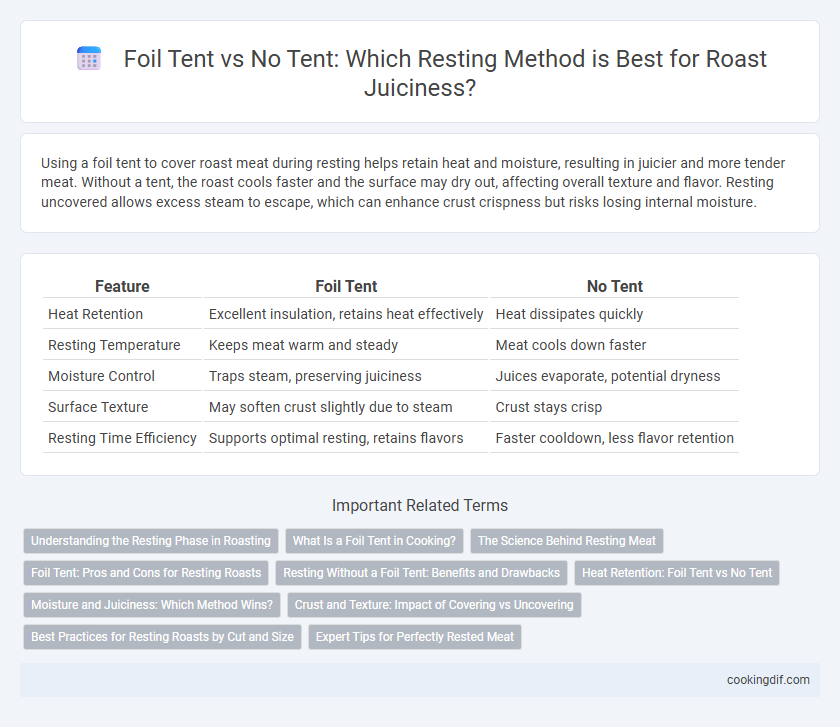Using a foil tent to cover roast meat during resting helps retain heat and moisture, resulting in juicier and more tender meat. Without a tent, the roast cools faster and the surface may dry out, affecting overall texture and flavor. Resting uncovered allows excess steam to escape, which can enhance crust crispness but risks losing internal moisture.
Table of Comparison
| Feature | Foil Tent | No Tent |
|---|---|---|
| Heat Retention | Excellent insulation, retains heat effectively | Heat dissipates quickly |
| Resting Temperature | Keeps meat warm and steady | Meat cools down faster |
| Moisture Control | Traps steam, preserving juiciness | Juices evaporate, potential dryness |
| Surface Texture | May soften crust slightly due to steam | Crust stays crisp |
| Resting Time Efficiency | Supports optimal resting, retains flavors | Faster cooldown, less flavor retention |
Understanding the Resting Phase in Roasting
Using a foil tent during the resting phase of roasting helps retain heat and moisture, allowing juices to redistribute evenly throughout the meat. Resting without a tent can lead to faster heat loss, potentially resulting in drier texture and less flavorful outcomes. Properly managing the resting environment is crucial for achieving optimal tenderness and juiciness in the final roast.
What Is a Foil Tent in Cooking?
A foil tent in cooking is a piece of aluminum foil loosely draped over food to retain moisture and heat during resting. It prevents the roast from drying out by trapping steam, allowing juices to redistribute evenly throughout the meat. Using a foil tent helps maintain optimal temperature and enhances tenderness without creating a soggy crust.
The Science Behind Resting Meat
Resting meat under a foil tent helps retain heat and moisture by reducing evaporative cooling and minimizing temperature loss, which allows juices to redistribute evenly within muscle fibers, resulting in a juicier and more tender roast. Without a tent, meat cools faster, causing juices to escape and the final product to be drier. Research in meat science confirms that controlled resting environments enhance flavor retention and improve meat texture by stabilizing internal temperatures after cooking.
Foil Tent: Pros and Cons for Resting Roasts
Foil tents create a controlled environment that traps heat and moisture, resulting in juicier and more tender roasts during resting. However, the retained steam can cause the roast's exterior to lose its crispy texture, which may be undesirable for certain recipes. Without a tent, roasts cool faster and maintain their crust, but risk drying out due to heat loss and moisture evaporation.
Resting Without a Foil Tent: Benefits and Drawbacks
Resting without a foil tent during a roast allows for enhanced airflow, promoting even cooling and reducing moisture buildup on the meat's surface, which helps maintain a crisp bark. However, lack of foil tenting can prolong resting time and increase exposure to environmental contaminants or insects, potentially affecting texture and safety. Balancing these factors is crucial for achieving optimal tenderness and flavor when deciding to rest meat uncovered.
Heat Retention: Foil Tent vs No Tent
Foil tents significantly enhance heat retention during resting by reflecting radiant heat back to the body, maintaining a warmer microclimate compared to no tent. Without a tent, heat dissipates rapidly into the environment, increasing the risk of faster body heat loss and reduced thermal comfort. The reflective properties of foil tents make them ideal for preserving core temperature in cold conditions during rest periods.
Moisture and Juiciness: Which Method Wins?
Using a foil tent during roasting traps steam and moisture, which enhances juiciness by preventing the meat from drying out. Without a tent, the surface crisps more as moisture evaporates, potentially leading to a less juicy result but a more caramelized crust. For optimal moisture retention and juiciness, a foil tent generally wins, especially during the resting phase where retained steam redistributes juices evenly.
Crust and Texture: Impact of Covering vs Uncovering
Using a foil tent while resting roast helps retain moisture, resulting in a softer crust and juicier interior as the tent traps steam and slows crust hardening. Resting without a tent allows the crust to dry more, forming a crispier, firmer texture favored by those who prefer a pronounced outer crust. Balancing the choice depends on desired crust thickness and overall roast texture preferences.
Best Practices for Resting Roasts by Cut and Size
Using a foil tent to rest roasts helps retain moisture and maintain heat, especially for larger cuts like prime rib or whole pork shoulders. Smaller cuts such as ribeyes or strip loins can rest uncovered briefly to allow a crust to form without losing temperature rapidly. Optimal resting time varies by size: 10-15 minutes for smaller cuts and 20-30 minutes for larger roasts to redistribute juices evenly.
Expert Tips for Perfectly Rested Meat
Using a foil tent during resting helps retain moisture by trapping steam, resulting in juicier, more tender meat with evenly distributed heat. Resting meat without a tent allows the exterior to form a slight crust, enhancing texture but may cause some moisture loss. Experts recommend loosely covering with foil for larger cuts to balance moisture retention and bark preservation, ensuring perfectly rested roast every time.
Foil tent vs no tent for resting Infographic

 cookingdif.com
cookingdif.com